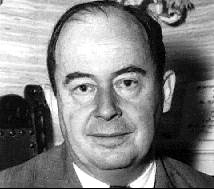| Profile | Major Works | Resources |
John von Neumann, 1903-1957

Born in Budapest, Hungary in 1903. After simultaneously earning a doctorate in mathematics from the University of Budapest and a doctorate in chemistry from the University of Zurich, John von Neumann joined the faculty of the University of Berlin in 1927. He moved to Princeton in 1932 where he became the youngest member of the IAS. During this time, he made important contributions not only to pure and applied mathematics, but also to physics and, in some ways, philosophy (esp. in relation to the quantum paradox). He was also active in the Manhattan Project (the development of the atomic bomb) and was one of President Truman's advisors on the Atomic Energy Commission. His later work on parallel processes and networks has earned him the label of the "father of the modern computer". As Nicholas Kaldor would later write, "He was unquestionably the nearest thing to a genius I have ever encountered."
An astoundingly creative mathematician, John von Neumann has played a rather important role in post-war economic theory through two essential pieces of work: his 1937 paper on a multi-sectoral growth model and his 1944 book (with Oskar Morgenstern) on game theory and uncertainty.
John von Neumann's famous 1937 paper - actually, originally written and presented by von Neumann at a Princeton seminar in 1932, but only published in the Spring of 1937, at Karl Menger's request, in the proceedings of the famous "Vienna Colloquium". It ostensibly derived from his reading of Wicksell and Cassel. The 1937 paper has been called "the greatest paper in mathematical economics that was ever written" (E. Roy Weintraub, 1983). It precipitated what Morishima later called a veritable "von Neumann Revolution" in general equilibrium, capital and growth theory. He introduced several important concepts in his 1937 paper, besides the obvious methodological one of resurrecting "mathematical economics". He bequeathed (1) the concept of "activity analysis" production sets, to be later extensively employed by Koopmans and the Neo-Walrasians; (2) linear system of reproduction as later used and developed by Leontief, Sraffa and the Neo-Ricardians; (3) price-cost and demand-supply inequalities which accounted for the Vienna Critique of Walrasian systems of equations; (4) the first use of a (generalization) of Brouwer's fixed- point theorem to prove the existence of an equilibrium, later to be known as Kakutani's Fixed Point Theorem; (5) The minimax and maximin solution methods and the saddlepoint characterizations; (6) early statements of duality theorems of mathematical programming and complementary slackness conditions; (7) a novel manner of incorporating fixed and circulating capital via joint production; (8) the elucidation of the concept of "balanced" or "steady-state" growth - later employed with gusto by Harrod, Solow, Hicks and the entire flow of growth models since; (8) derivation of the "Golden Rule" - showing that the rate of interest is related to the rate of growth rather than the quantity of capital, anticipating Allais and the "optimal growth theory" and the turnpike theorems of Koopmans, Radner and others.
John von Neumann's 1944 book with Oskar Morgenstern, Theory of Games and Economic Behavior was a landmark of twentieth century social science. The theory of games (what he called "Gessellschaftsspiel") had been single-handedly invented nearly a couple decades earlier by John von Neumann in a 1928 article, wherein he set up a two-person zero-sum game and provided a proof of the minimax theorem. The matter had laid dormant until von Neumann dusted it off again in the 1944 book, with another proof and more solution concepts. Besides launching entire field of Game Theory, the 1944 book introduced several other important elements used in other fields of economics, such as the axiomatization of utility theory per se (as later pursued by Arrow, Debreu, etc.) and the axiomatization of the theory of choice under uncertainty, i.e. the formalization of the expected utility hypothesis.
|
Major (economic) works of John von Neumann
|
HET
|
|
Resources on J. von Neumann
|
All rights reserved, Gonšalo L. Fonseca
